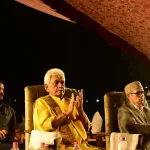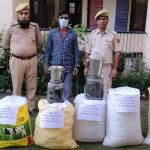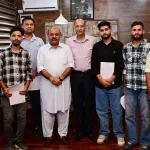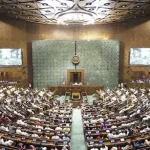Dr. Homi Jehangir Bhabha, popularly known as Homi Bhabha, the father of the Indian Nuclear Programme, was a famous nuclear physicist. He was the founding director of two renowned research institutes- the Tata Institute of Fundamental Research (TIFR) and the Bhabha Atomic Research Centre (BARC). He was the first person to become the Chairman of the Atomic Energy Commission of India. Having started his scientific career in nuclear physics from Great Britain, Bhabha returned to India and played a key role in convincing the Congress Party’s senior leaders, most notably Jawaharlal Nehru, to start the ambitious nuclear programme. With Nehru’s support, the Atomic Energy Commission was set up in 1948 with Bhabha as its head. His vision entailed an autonomous body answerable to the Prime Minister of India and exercising a broad mandate in its domain. He was wise enough to insist on cutting out the generalist civil service and as well as the new body being run by technocrats and manned by specialists. Secrecy was also embraced as a paramount virtue as any such state activity will attract hostile foreign interests determined to wreck it.
Homi Bhabha was born into an affluent family in Bombay on October 30, 1909. His parents, Jehangir and Meheren Bhabha were a very enlightened and remarkable couple and young Homi and his younger brother Jamshed grew up in a charming home with books and music as their companions. He blossomed into youth breathing in a rarefied air that created in him a sense of the sublime and absolute. At school, he mastered French, Latin and had read Einstein’s theory of relativity even before he sat for his Senior Cambridge exams. It was all too dazzling for the impressionable young Indian, who now proceeded to junk the mechanics of engineering for the metaphysics of frontier science. Exciting new discoveries had been made in atomic physics in recent years and with sufficient hard work and talent, a young researcher could do path breaking and original research in the field.
Bhabha proceeded to study cosmic rays and electron showers, a field in which he made his name during much of the 1930’s. India became nuclear state among very few countries in the world at early stage of freedom. Most of the credit for emerging India as a nuclear power goes to Homi Jehangir Bhabha. When the Second World War started in 1939, Bhabha happened to be on holiday in India. Thereafter he lived in India. As the international stresses gradually diminished in the decade following the War, Bhabha came to play an ever-increasing role in international scientific affairs. M. G. K. Menon considers that the five years Bhabha spent at the Indian Institute of Science in Bangalore was ‘the period when he found his mission in life; when he became aware of the role he would play in the development of India’
In 1965, Homi Bhabha had declared on All India Radio that he could make India a nuclear-armed country within 18 months if given the go-ahead. This sent shivers down the spines of world powers. Bhabha’s contribution to the development of atomic energy made him a significant figure in international scientific circles. He served as president of the United Nations Conference on the Peaceful Uses of Atomic Energy in 1955 and as president of the International Union of Pure and Applied Physics from 1960 to 1963. In January 1933, Bhabha received his doctorate in nuclear physics after publishing his first scientific paper, “The Absorption of Cosmic radiation”. In the paper, Bhabha offered an explanation of the absorption features and electron shower production in cosmic rays. The paper helped him win the Isaac Newton Studentship in 1934, which he held for the next three years. The following year, he completed his doctoral studies in theoretical physics under Ralph H. Fowler. During his studentship, he split his time working at Cambridge and with Niels Bohr in Copenhagen.
In 1935, Bhabha published a paper in the Proceedings of the Royal Society, Series A, in which he performed the first calculation to determine the cross section of electron-positron scattering. Electron-positron scattering was later named Bhabha scattering, in honour of his contributions in the field. Bhabha later concluded that observations of the properties of such particles would lead to the straightforward experimental verification of Albert Einstein’s theory of relativity. In 1937, Bhabha was awarded the Senior Studentship of the 1851 exhibition, which helped him continue his work at Cambridge until the outbreak of World War II in 1939. Bhabha gained international prominence after deriving a correct expression for the probability of scattering positrons by electrons, a process now known as Bhabha scattering. His major contribution included his work on Compton scattering, R-process, and furthermore the advancement of nuclear physics. Bhabha represented India in IAEA and in 1955, was also the President of the United Nations Conference on the Peaceful Uses of Atomic Energy in Geneva. Bhabha was instrumental in devising the strategy behind the country’s nuclear programme. He pioneered the use of thorium to extract uranium from it rather than relying on the meagre reserves of uranium in India. He formulated India’s three-stage nuclear power programme.
During the 56 years of his life he grew to know and understand many countries. The account of Bhabha’s life reads like that of a great international statesman. The United Kingdom, the United States of America, the Soviet Union, Denmark, Holland, Switzerland, France, Canada, Australia, Italy and many others had welcomed him to work with their own scientists on some common task at some period of his life, and in all of them he had many friends who will remember him with deep affection. The famed radio telescope in Ooty, India was his initiative, and it became a reality in 1970. The Homi Bhabha Fellowship Council has been giving Homi Bhabha Fellowships since 1967. He was among very few people in India who realized the significance of atomic energy very early. When India got freedom, he was also offered a post in the Cabinet. However, he rejected the offer and became the scientific advisor to former Prime Minister Jawaharlal Nehru and Lal Bahadur Shastri. On the request of physicist Dr. C V Raman, then director of the Indian Institute of Science, Bangalore (Bengaluru), he joined the institute as a reader in physics in 1940.
Bhabha was elected a Fellow of the Royal Society of London in 1941. He was awarded the Adams prize in 1942 for a thesis on ‘The theory of the elementary particles and their interaction’. In 1948 he was awarded the Hopkins prize of the Cambridge Philosophical Society. He was also given the Melchett Award of the Fuel Institute in London. His services to India were recognized in 1954 by the award of the Padma Bhushan. In 1957, he was elected an honorary fellow of Gonville and Caius College and also elected to honorary fellowship of the Royal Society of Edinburgh. In 1959 he was elected to honorary fellowship of the American Academy of Arts and Sciences. In 1963 he was elected a foreign associate of the National Academy of Sciences of the United States. He was awarded honorary doctoral degrees in science at Patna (1944), Lucknow (1949), Banaras (1950), Agra (1952), Perth (1954), Allahabad (1958), Cambridge (1959), London (1960), Padova (1961). Goverment of India issued a postal stamp in his name to honour the scientist. Other noted institutions in his name are the Homi Bhabha National Institute; an Indian deemed university, Homi Bhabha Centre for Science Education and the Bhabha Atomic Research Centre (BARC). BARC (formerly known as the Atomic Energy Establishment) is India’s leading nuclear research facility located in Bombay. Homi Bhabha was awarded the Adams Prize (1942) and Padma Bhushan (1954). He was also nominated for the Nobel Prize for Physics in 1951 and 1953–1956.
Bhabha remained a bachelor during his life. His hobbies included painting, classical music and opera, and botany. He was killed in mysterious circumstances, aged 56, when Air India Flight 101 crashed on January 24, 1966 near Mont Blanc in Switzerland, while heading to Vienna, Austria to attend a meeting of the International Atomic Energy Agency’s Scientific Advisory Committee. It had 11 crew members and 106 passengers. None survived. Bhabha was one of the ill-fated passengers. At the time of his death, Bhabha was Director and Professor of Theoretical Physics of the Tata Institute of Fundamental Research, Secretary to the Government of India in the Department of Atomic Energy and also ex officio Chairman of the Indian Atomic Energy Commission, and Director of the Atomic Energy Establishment at Trombay. Mrs Indira Gandhi said: ‘To lose Dr Homi Bhabha at this crucial moment in the development of our atomic energy programme is a terrible blow for our nation. He had his most creative years ahead of him. When we take up the unfinished work he has left behind, we will realize in how many fields he served us. For me, it is a personal loss. I shall miss his wide-ranging mind and many talents, his determination to strengthen our country’s science and enthusiastic interest in life’s many facets. We mourn a great son of India.’
Homi Jehangir Bhabha is recognised as the father of India’s nuclear programme. Had it not been for his historic contributions to India’s nuclear programme from the 1940s to the 1960s, India would not have been as advanced a nuclear-powered and armed nation as it is today.
“My success will not depend on what A or B thinks of me. My success will be what I make of my work”………..Homi J. Bhabha
(Author is a regular writer for this newspaper and can be reached at [email protected])





